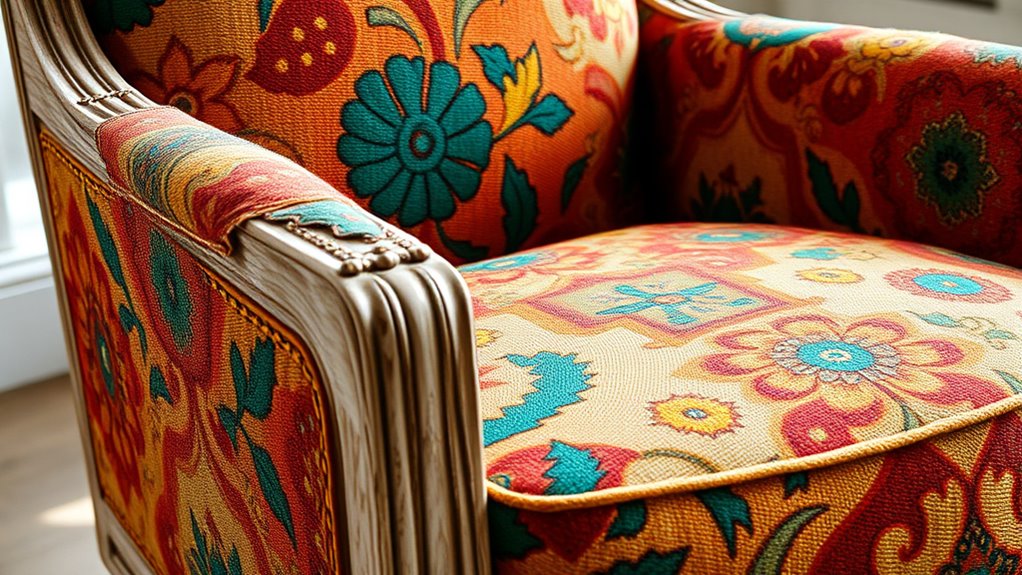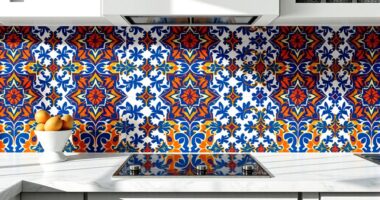Reupholstering your old chairs with boho fabrics is a fantastic way to give them new life and a fresh, stylish look. Choose bold patterns like tribal or geometric designs in natural fibers for a relaxed vibe. Carefully prepare your chair, then follow step-by-step instructions to remove old fabric, cut your new material, and secure it tightly. For a polished finish, pay attention to corners and edges. Keep exploring tips to maintain and refresh your boho furniture, and transform your space beautifully.
Key Takeaways
- Choose bold, patterned boho fabrics like tribal or geometric designs for a striking transformation.
- Prepare the chair by inspecting, cleaning, and reinforcing the frame before removing old upholstery.
- Measure and cut fabric generously, then attach it tautly using staples or nails, folding corners neatly.
- Secure the fabric smoothly, hiding staples under finished edges or trim for a professional look.
- Maintain your boho-upholstered chair with regular cleaning, fabric protectant, and avoiding prolonged sunlight exposure.
Choosing the Perfect Boho Fabrics for Reupholstery

When choosing boho fabrics for reupholstery, it’s essential to select materials that reflect the eclectic and textured style of the trend. Focus on boho fabrics that showcase bold patterns, like tribal or geometric designs, to create eye-catching upholstery. Natural fibers such as cotton, linen, and jute are perfect choices because they add a relaxed, earthy feel to your furniture. Consider large-scale prints or abstract motifs, especially for tall chairs, to maintain proportion and visual interest. Additionally, incorporate color palettes with warm neutrals, deep blues, terracotta, and metallic accents to enhance the layered, vibrant aesthetic typical of boho style. To ensure durability, choose fabrics that are suitable for upholstery and can withstand daily use. Being aware of material selection helps you make informed choices that balance style and function. Incorporating texture variety can further elevate the tactile appeal of your reupholstered piece. Exploring different fabric textures and understanding their wearability can add depth and richness to your design, making your furniture truly standout. By carefully selecting these elements, you’ll craft a unique, inviting piece that embodies the free-spirited essence of boho decor.
Preparing Your Chair for a Stylish Makeover

Before you begin reupholstering, it’s essential to thoroughly prepare your chair to guarantee a polished, long-lasting result. Start by inspecting the old chair’s frame for any damage or loose joints, reinforcing weak areas with wood glue and screws. Carefully remove the existing upholstery, tacks, and nails with a painter’s tool or pliers to avoid damaging the wood or frame. Measure and record the dimensions of the seat and backrest, adding extra margin to your fabric cuts for ample coverage and easier attachment. Sand and clean the wooden surfaces, then apply a protective finish or wax to enhance durability. Finally, assess the foam and padding, replacing any disintegrated or compressed materials to ensure comfort and support when you reupholster with your new fabric.
Step-By-Step Guide to Reupholstering With Boho Textiles

Reupholstering with boho textiles is a rewarding project that transforms your furniture into a vibrant statement piece. To start, measure and cut your boho fabrics with generous margins, ensuring enough material to wrap around edges and corners securely. Remove the old fabric and upholstery nails, then attach the new fabric from the center of each side, pulling taut to prevent wrinkles. Use staples or original nails to secure the fabric, working systematically for a professional finish. Fold and tuck fabric neatly at corners and edges, overlapping seams as needed to keep your furniture makeover polished. Consider incorporating positive thinking principles to approach your DIY project with confidence and creativity. Proper color accuracy in your fabric choices can make your furniture truly stand out. Additionally, understanding IRA tax implications can help you plan your future savings more effectively. Incorporating upholstery techniques, such as padding and layering, can enhance durability and comfort. Being mindful of style cohesion ensures your reupholstered piece complements your existing decor. Finally, trim excess fabric, smooth out any wrinkles, and consider adding decorative trim or staples for extra detail. This DIY upholstery project enhances your home decor with a personal touch.
Securing and Finishing Your Boho Chair Covering

Securing and finishing your boho chair covering guarantees a polished, professional look that lasts. Begin by using a staple gun to secure the fabric, placing staples about 1/2 inch apart for an even, tidy finish. Tuck and fold fabric edges neatly into corners and gaps to minimize puckering and create a smooth appearance. For a clean look, staple close to decorative trim or edges, hiding staples beneath finished details. Use extra staples sparingly around curves and pleats to maintain tension and prevent sagging over time. Once secured, trim any excess fabric carefully, folding raw edges under or into gaps for a tidy, polished final result. Proper securing and finishing ensure your boho chair looks beautifully revamped and professional. Additionally, paying attention to effectiveness of eye patches can inspire you to incorporate soothing treatments into your relaxation routine after completing your project. Incorporating quality fabrics can further enhance the durability and aesthetic appeal of your reupholstered furniture, especially when selecting durable materials that withstand regular use.
Tips for Maintaining and Updating Your Boho-Style Furniture

Maintaining your boho-style furniture helps preserve its vibrant look and extends its lifespan. Regularly applying a fabric protectant can prevent stains and spills from causing damage, making furniture maintenance easier. To refresh your pieces, rotate or reposition them periodically, ensuring even wear and fading. Keep fabrics looking lively by vacuuming or brushing them to remove dust and dirt buildup. Avoid prolonged exposure to direct sunlight, which can cause fading or discoloration over time. For deeper cleaning, use gentle, fabric-specific cleaners and test on a small area first to prevent damage. If you notice signs of wear, consider a furniture update by reapplying fabric protectant or replacing accessories like cushions. Additionally, selecting vetted Halloween products can inspire seasonal updates that keep your decor fresh and engaging. Incorporating weather-resistant fabrics into your furniture choices can also help prolong their beauty and usability through different seasons. Being aware of headphone types and compatibility can enhance your listening experience when relaxing with your updated decor. Staying informed about digital literacy programs can also help seniors better maintain their furniture and enjoy their living spaces. Consistent care keeps your boho furniture looking beautiful and prolongs its charm.
Frequently Asked Questions
Is It Worth Reupholstering an Old Chair?
You might wonder if reupholstering an old chair is worth it. The answer is yes, especially if the frame is sturdy. It’s a cost-effective way to refresh your space and preserve sentimental or vintage pieces. Plus, you get the chance to choose trendy fabrics like boho styles, making your furniture both functional and stylish. Reupholstery extends your chair’s life while reducing waste, making it a smart and eco-friendly choice.
How to Spruce up an Old Chair?
To spruce up an old chair, start by removing the old fabric, tacks, and padding to check the frame’s condition. Repair any loose joints with wood glue and screws. Pick a bold boho fabric with large patterns to add personality. Cut the fabric generously, then secure it tightly with a staple gun, folding edges neatly. Finish by trimming excess fabric and adding decorative nails for a polished, fresh look.
How Much Does It Cost to Reupholster a Fabric Chair?
You might think reupholstering a fabric chair is expensive, but costs vary. Usually, it ranges from $300 to $700 for standard fabrics, with high-end or boho patterns adding $100 to $300. Doing it yourself drops costs to about $100-$250, mainly for fabric and tools. Remember, labor can be half or more of the total, and extra repairs or trims can add to your expenses.
Do You Have to Remove Old Fabric When Reupholstering?
When reupholstering, you usually have to remove the old fabric first. This step guarantees a smooth, clean surface for the new material, preventing lumps and unevenness. It also helps you access the frame and padding for repairs and allows better adhesion of staples or glue. Plus, removing old fabric improves indoor air quality by eliminating dust, allergens, and pests, making your project cleaner and more durable.
Conclusion
Revamping your old chair with boho fabrics is a fun, rewarding project that can transform your space. Imagine turning a tired, outdated piece into a vibrant, cozy focal point—like Sarah did with her vintage armchair, giving it a fresh, boho-chic look that now steals the show in her living room. With a little creativity and effort, you can breathe new life into your furniture and create a unique, stylish piece you’ll love for years to come.










